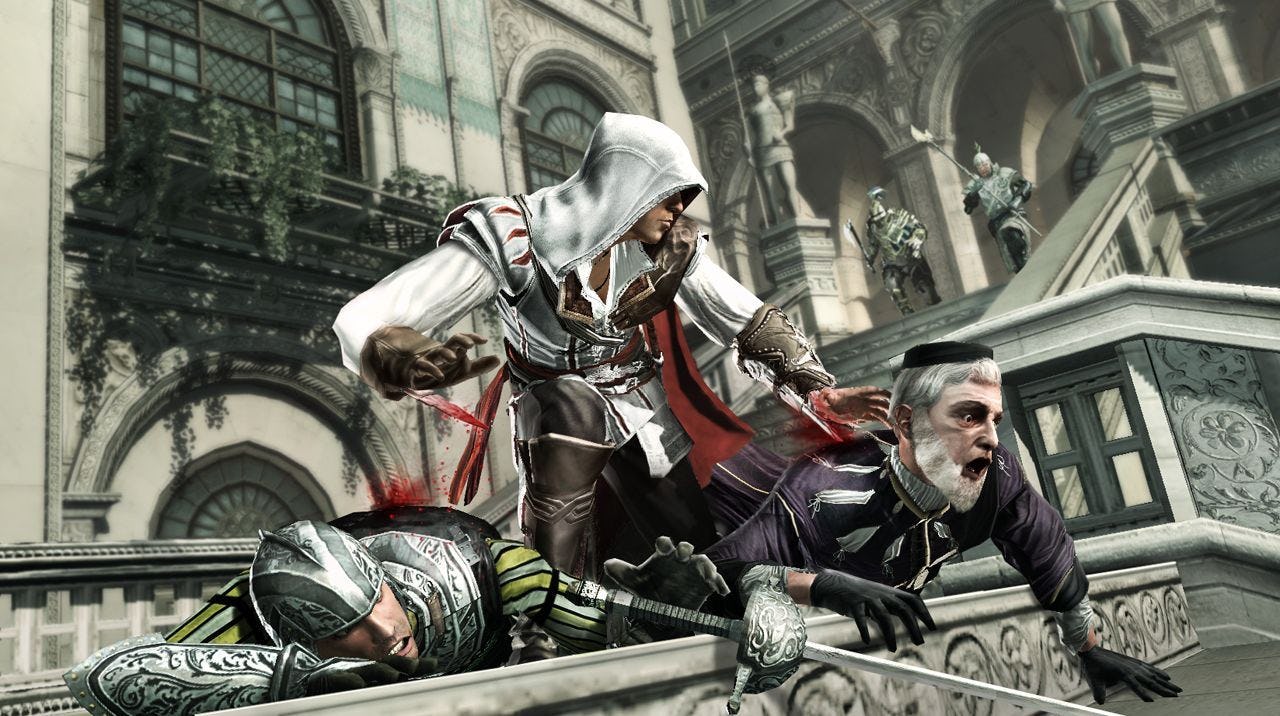
In the fall of 2007, I fondly remember sitting in my freshman-year shop class overhearing some of my classmates talking about the week’s hottest new release. The hype of Assassin’s Creed, Ubisoft’s new, historically-themed open-world game, had caught their hearts and minds. I could admit that a big new game set during the Crusades was a pretty awesome concept. But the lukewarm preview coverage from magazines and websites made me cautiously optimistic.
Later that week, getting top marks on the school year’s first big test earned me a trip to Best Buy. Standing in front of rows and rows of excellent Fall games, I noticed two copies of Assassin’s Creed left, and recalled the enthusiastic chatter from school. I was a fan of Ubisoft Montreal’s Splinter Cell and its underrated 2001 Batman game. So I figured, “Why not?” and picked up a copy of this weird game people couldn’t stop talking about.
Within a week of purchase, the reality of Assassin’s Creed’s promise set in. For everything it did right, there was a shortcoming. There was a cool, present-day storyline in the background, but it ultimately didn’t amount to more than a few interactive cutscenes. The open world was distinct from every other game in the genre, but there wasn’t a whole lot to do besides collecting flags and completing basic missions. Assassin’s Creed might have been the first game I ever played and concluded, “This is fine, but a sequel to this could be something special.”

Just two years later, my astute observation was proven correct. Ubisoft Montreal took all of the very fair criticisms it received for its 2007 game and addressed virtually every gripe. The result was Assassin’s Creed II, a classic game widely regarded as the early peak of the franchise, and a perfect example of why sequels in gaming are oftentimes more important than the initial idea.
Assassin’s Creed II was a minor reset for the ideas that made the first game so distinct. We were no longer in the Middle East during an era of religious tension and despair. Instead, players were smack dab at the opulence and enlightenment of Renaissance Era Italy. Altair, the dutiful and brooding (and boring) protagonist from the first game was replaced by Ezio Auditore da Firenze, a suave himbo-turned-master-Assassin, who must deal with an unthinkable tragedy that strikes his affluent family. Ezio remains one of the medium’s greatest characters, one whose shadow still looms over a franchise full of charismatic leading men and women.
Assassin’s Creed II is ultimately about revenge. But it’s also a game about rebounding from those dark emotions with the help of friends and family. Ezio’s character development through his first adventure as an assassin is something to be appreciated even all these years late. It’s both relatable and fun to watch. His story is a pretty stark difference from the singular note of duty and conspiracy that the first game reveled in.
The gameplay department is where Assassin’s Creed II really outshines the original. The cities of Florence, Venice, San Gimignano, and Forlì are filled with chests that rewarded currency, shops to spend that money on, different enemy types, and new ways to blend into the crowd. For players willing to dig a little deeper, there are puzzles to solve, secret anomalies that connect the 1400-era world to the series’ bizarre lore, and hidden tombs that tested players’ parkour abilities.
Combat, arguably the most fleshed-out part of the first game, gains even more depth as there are now armor sets to consider and weapons to choose from. Those who like to customize their character could now buy different colored Assassin robes. In Monteriggioni, Ezio has a family estate to invest in and customize, increasing its value and periodic income for the surrounding villa.
Even collectibles were given a complete overhaul. The pointless Templar flags from the first game were replaced with items directly tied to the game’s story. If the player manages to collect them all, they aren’t just given an achievement and a pat on the back for their troubles. The game’s story rewards them with a heavy, emotional gut punch.

Assassin’s Creed II was an open-world game in the post-Grand Theft Auto San Andreas era, one that understood the potential of Ubisoft Montreal’s coolest idea year. It was an Italy teeming with stuff to do and activities that fed into the greater sense of progression. It made good on all of the promises that the first game didn’t live up to despite flashes of brilliance throughout. And it was supported by a memorable story and endearing characters.
No title better reveals why divisive video games deserve second chances. To this day, it’s often referenced as the best-case scenario for games like Star Wars Outlaws or Starfield that show promise despite an underwhelming debut. In an era where one misstep or underperforming game can result in the closure of a studio or the cancellation of a great idea, it’s worth remembering that the success of Assassin’s Creed as a series only happened because of the publisher and developer’s ability to see potential in exceptional ideas.
After a false start in 2007, Assassin’s Creed II marked the true beginning of one of gaming’s most popular and enduring franchises, one that wouldn’t have been possible without it.






